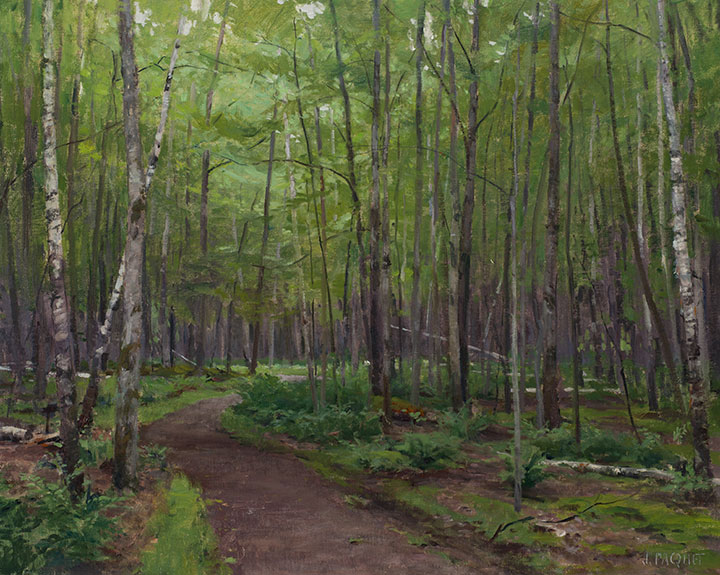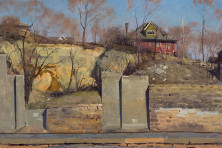Questions & Artists: Joe Paquet (Part I of II)
- Share
- Tweet
- Pin
- Share

We, living in Door County, are fortunate to have a large number of great artists living and working in the Midwest. This two-part Q&A is with one of these accomplished painters, Joe Paquet.
Those readers who remember some of my previous interviews will perhaps remember Derek Davis and recently, Carl Bretzke mentioning Mr. Paquet as being instrumental in their development as artists. Another great Midwestern artist and a man I paint with frequently, Rick Brawner, said Mr. Paquet is one of his two favorite painters. Mitchell Albala in his outstanding book, Landscape Painting has Joe’s painting “Edge of Evening” as an example of how to “do it.”
I think you will find this interview filled with some of Paquet’s interesting and informative thoughts on painting. You can see more of his work at joepaquet.com and subscribe to his newsletter, which I recommend.

“Blue Collar” by Joe Paquet.
Randy Rasmussen (RR): Mr. Paquet, where were you born and raised?
Joe Paquet (JP): I was born and raised in Wayne, New Jersey.
RR: When did your interest in art start?
JP: I know this is a cliché but I can always remember drawing.
RR: Virtually every artist I have interviewed has that answer. I think drawing skillful renderings really starts the process. You seem to be not only an artist but also a writer. I really enjoyed reading on your website the article, “Why Paint Plein Air.” Do you enjoy writing?
JP: The writing turned out to be something of a surprise. I journaled and read for years but began writing for my newsletter at the suggestion of my web-maestro Mitch Rossow over five years ago. Somehow the words come to me and I enjoy the process. I think writing requires the same elements as painting.
RR: When did you know you were going to be an artist?
JP: After art school I began studying the prismatic palette with John Osborne. I found what I was looking for and knew then I would become a fine artist.
RR: I urge readers to go to your website and read the long version but for this Q&A, can you tell our readers why you paint plein air?
JP: Painting outdoors is first a sensory experience. The more senses that are engaged the greater the possibility of a real connection to the subject.

“A Gentle Indifference” by Joe Paquet.
RR: How did your mentor, John Foote, open your eyes to the joy of drawing the human form?
JP: At the School of Visual Arts in New York, I was fortunate to have extraordinary drawing teachers, among them the great illustrator James McMullan and John Foote. I was a provincial kid who had never gone anywhere or experienced many things…these generous teachers opened up the world of great drawing to me.
RR: Do you paint every day?
JP: I go through periods when I paint intensely for a period of time outdoors. However, I teach my own classes on Wednesday and Thursday evenings for semesters in spring and fall. Additionally I track five or six workshops across the United States and Europe. It is a bit of a balancing act.
RR: The prismatic palette is what you use. What are the colors you use?
JP: Lead white, cad yellow light, cad yellow, cad orange, cad scarlet, cad red, alizarin crimson, manganese blue, cobalt blue, ultramarine blue, and ivory black.
In part II, Mr. Paquet begins by explaining how he uses the prismatic palette and why he thinks it can help painters.


